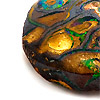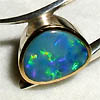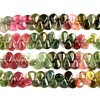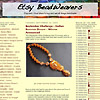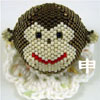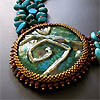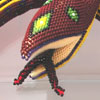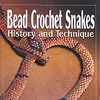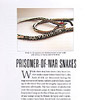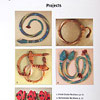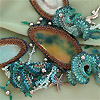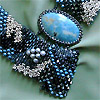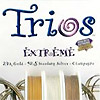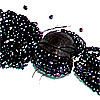October, 2009

Happy Halloween!Happy Halloween, dear friends! We treat, no tricks! Read in our October's issue:
Legends on opal and tourmaline
Contact us with any questions at
info@mylovelybeads.com.
Etsy BeadWeavers Team Featured artist - Adele Recklies Bead crochet snakes Diversity of styles - Galina Bursuk Flex your creativity! What is passementarie? Coral technique as 1-2-3 November upcoming events Best regards,
MyLovelyBeads.com Team |
Legends on opal and tourmalineOpal and tourmaline are the gemstones for October. In a cave in Kenya, Louis Leakey, the famous anthropologist, uncovered the earliest known opal artifacts. Dating back to about 4000 B.C., they most likely came from Ethiopia. Historically, opal discoveries and mining progressed similarly to the ways diamond, emerald, ruby and sapphire were produced. As early humans found various gemstones, they slowly learned to work them into decorative shapes. As communities developed, gems became symbols of wealth. In the Old World, Hungary mined opal for Europe and the Middle East. Mexico, Peru, and Honduras supplied their own native empires with the gemstone. Conquistadors introduced New World opal to Spain when they returned with stones in the early sixteenth century. Since the late 1800's, Australia has dominated opal production with more than ninety per cent of the global output. Opal of differing qualities occurs in more than twenty other countries, including Zambia, Ethiopia, Guatemala, Poland, Peru, Canada, New Zealand, Indonesia, the USA, Brazil, and Mexico. Read more on the history of opal here. Ancient legend says that tourmaline is found in all colors because it traveled along a rainbow and gathered all the rainbow's colors. For centuries, various cultures have had different beliefs about what virtues the tourmaline can bring to the wearer. In 18th Century literature, Barbara Walker cites references, which considered this stone to be helpful to artists, authors, actors and those in creative fields. In the same century, a Dutch scientist claimed that a tourmaline wrapped in silk and placed against the cheek of a feverish child would induce sleep. In Africa, tourmaline was once used as a stone to awaken one from "the dream of illusion". Ancient ceremonies in India included the use of the gem as a tool to bring insight and help in the discovery of that which is good. It would also serve to make known who or what was the cause of troubles or evil deeds. Native Americans have used pink and green tourmaline as funeral gifts for centuries. In modern times, the stone is used by tribes in Africa, Native Americans, and aboriginal groups in Australia as a talisman that protects against all dangers. In fact, at one time in history, pink and red tourmaline were thought to be rubies. Pink tourmaline tends to be pinker in color than ruby. However, their similarities in appearance are so strong that the stones in the Russian crown jewels believed to be rubies for centuries, are now thought to be tourmalines. |
|
Etsy BeadWeavers Team
Have you ever heard of the Etsy BeadWeavers Team? Maybe you have heard of it once, but you're not sure where and when? Or perhaps you have no idea what Etsy is and what it stands for? Make yourself comfortable, I will tell you all you need to know. Etsy was born on 18 January 2005. Its parents, Robert Kalin, Chris Maguair and Haim Schopic, have no idea why their little e-company got this name. Time passed, and the little private company with the funny name became one of the largest Internet-based portals for selling and buying handmade creations and the supplies to make them. Moreover, it is currently considered the main alternative to eBay for selling handmade items. On Etsy you will find paintings, art prints, handmade postcards and fridge magnets, make-up, pre-made homepage banners, fabrics, yarn, clothes, and, of course, jewelry and accessories. Anybody can open a store on Etsy and sell their unique creations. Shop-owners often form mutual support groups called Etsy Teams, based on the techniques and materials they are using in their creations, their common interests, or the geographic area they live in. One of these groups is the Etsy BeadWeavers Team, of which I am proud to be a member. The group was founded in 2007 and it currently consists of more than 200 members. Who are those Etsy BeadWeavers? We are a group of free-spirited artists who use tiny seed beads to make their creations: jewelry, accessories, and even interior design. Most of the members live and work in the USA but we have EBW members spread all over the world. Etsy BeadWeavers is quite a diverse bunch of personalities. Among our members you will find representatives of various ethnic and age groups, professions and religions. Despite being so different in our geographical locations and lifestyles, all of us are united by our passion for beading in any form - from traditional and folkloric to modern and experimental.
Full article on Etsy BeadWeavers Team
|
|
Featured artist
For sure, you know the name of Adele Recklies from Brooklyn, NY, whose article was published in the last issue of the Bead & Button Magazine and who is the author of the Bead Crochet Snakes: History and Technique book. When we invited Adele to our newsletter and she agreed, we were really happy. Adele says on her bead passion, "I came to beading via my work as a theatrical costume maker. After I received a Ph.D. in theater, I decided that I really wanted to make the gorgeous costumes that I saw in the movies and theater rather than study them, so my husband and I moved to New York. I soon landed a job at Barbara Matera Ltd., one of the premier costume houses in the world. There I learned many couture techniques while making spectacular gowns and historical costumes, but it was the beading done at the shop that caught my eye. Working for a second costume shop gave me more hand-on experience with beading on fabric. That led me to take a series of seed bead jewelry classes. Although I eventually left the costume shops to open my own business making knitted and crocheted costumes for theater and film (my other love, and my work has been seen in films such as "Lemony Snicket's A Series of Unfortunate Events," "Big Fish," "Charlie's Angels: Full Throttle," "M:I:3," and "Memoirs of a Geisha," my knitting has also been part of "CATS" on Broadway as well as productions at the Metropolitan Opera and New York City Ballet), I have continued to explore beading. A bead crochet class with Miriam Milgram opened my eyes to the possibilities of tubular bead crochet and prompted my study of antique bead crochet snakes. Miriam had made her own version of the bead crochet snakes produced by women in Balkan villages and promised to teach a class in making a snake. When that didn't happen, I started my own research, discovered photos of antique bead crochet snakes made by Balkan villagers and Turkish prisoners of war during World War I, and figured out my own bead crochet snake pattern. I, however, didn't want something that would just sit on a table so I made snake necklaces and bracelets."
Full article by Adele Recklies
|
|
Bead crochet snakesIntroduction The story of bead crochet snakes is a rich one that involves the geographical area formerly referred to as the Balkans and known today as Southeastern Europe. Crochet, with or without beads, was well established in the Ottoman Empire by the 1870s. Most bead crochet items made before World War I were done by women for their own use, but the bead crochet snakes that intrigue people today were made after 1915. The majority of beadwork reptiles made in the Balkans can be divided into three types: snakes and lizards made by Turkish soldiers imprisoned in British military and civilian internment camps during World War I, snakes made by villagers in parts of Southeastern Europe for their own use, and less elaborate snakes made to be sold at markets as souvenirs or made specifically as jewelry. World War I Some of the 150,000-250,000 Turkish soldiers captured by the British, Australian, Russian, and French armies were housed in camps located in Egypt, on the island of Cyprus, and at Salonika. To combat the boredom of imprisonment, prisoners of war were allowed to craft souvenirs that could be given as gifts, bartered for amenities such as extra food, or sold in local shops and by street vendors. Many Turkish soldiers used beads to make handbags, purses, necklaces, bracelets, bookmarks, belts, covered bottles, snakes, and lizards. While most of the beadwork snakes and lizards were undoubtedly made in Middle-Eastern camps, some of them were made by the one hundred Turkish men interned at Knockaloe Camp on the Isle of Man. Family legends tell of Turkish prisoners trading beadwork snakes to locals for food.
Full article by Adele Recklies on Bead Crochet Snakes
|
|
Diversity of styles
Galina Bursuk says that working with beads has not only filled an empty part of her life, but has helped her provide an outlet to express her emotions. Beading is just a hobby for her, but Galina devotes all of her spare time to it - not for the purpose of selling her work, but simply to make women happy when they wear her art. Since an early age Galina has been crafting; frivolte, macrame, knitting, lace and more. She discovered beading in 2006 when she saw beaded gemstone jewelry and was impressed by this unusual media combination. She knew right away that this was what she wanted to do. So, she took classes where she learned basics and continued studies on her own. She found the Wonderful Moments Magazine (Chudesnie mgnoveniya) the most valuable reading at that time and she loved to purchase each new issue as it came out. Then she started looking for books, and she learned a lot from those she found. Galina then began using the Internet to find beading resources and found more than she expected. She found interesting tutorials and patterns there as well as shared ideas and learned from others' experience. The ability to contact other beadworkers is a great find for any beginner. At first, she created her beadworks using patterns of other designers., but soon understood that she got much more pleasure working on her own designs. Galina lives in Chernovtsi, Western Ukraine and graduated from the Medical University, MD in roentgenology. In her beadwork she takes her inspiration from almost anything, and the style of her beadwork is very unique. She has so many ideas that sometimes designing a piece takes more time to create it. Her favorite colors are shades of yellow, green and brown, but in her later works she began to use other color combinations as well. Quality beadwork is the highest priority for Galina so she devotes much attention to each piece. Since the end of 2007 Galina has been participated in beadwork contests and exhibitions, where she has won a few awards. In addition, photos of her beadwork have been published in many magazines and she takes part in beadwork communities, sharing her experience as others had with her when she began. |
|
Flex your creativity!Flex Your Creativity is an interesting beading contest that is being held by SoftFlex Company now. Contestants had to create a pieces of jewelry using one of the suggested so called "trios" beading wire. Zoya Gutina selected Extreme Trios, created two pieces, Bridal Flowers Necklace and Pearl Fireworks Necklace, and submitted them to the contest. The price of the Extreme Trios didn't seem to be low and we have decided to know more about Extreme, that's why we've written an email to Sara Hardin, marketing manager of SoftFlex. The response was received next day. Sara wrote, "The new Extreme is our only brand that is not using steel in the core. We are using 19 strands of a softer alloy in an innovative way to create a wire that strong but also easier on the environment. There is a lot less waste and pollution in the manufacturing process when the machinery isn't working such a hard material (steel). The silver and gold are plated, the champagne is nude and then the entire product is coated in our premium nylon coating." When we asked about 19 strands, Sara said, "19 itty bitty strands of a metal alloy braided together, plated in 24 karat, 925 sterling silver or just bare (champagne) and then coated in a nylon coating. It is hypo-allergenic & non-tarnishing." Zoya says, that Extreme wire is a nice material to work with. Flex Your Creativity Beading Contest is still open to vote. Choose the Winner! |
|
What is passementarie?Recently we've understand how old passementarie and vintage Czech beads look like. The story of our research began when Nancy Reinke, a friend of Zoya Gutina, gifted her a few pieces of some beadwork that Nancy found out in her trunk. According Wikipedia, passementerie or passementarie is the art of making elaborate trimmings or edgings (in French, passements) of applied braid, gold or silver cord, embroidery, colored silk, or beads for clothing or furnishings. Passementarie pieces, Zoya received from Nancy, were made using vintage Czech beads - mostly real charlotte and 3-cut beads, and they are more than a hundred years old. Beads are sparkling with blue and brown and look gorgeous! We'd like to share with you these exciting pictures demonstrating an old beadwork on passementarie. |
|
Step by step. Coral technique as 1-2-3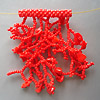
No doubt, many people like jewelry that look like corals. Making them seems to be very complicated, but in general, it's not so difficult to create "corals" using beads. Victoria Katamashvili says, that it's as easy, as 1-2-3! You can try! |
|
Upcoming events22nd Annual Washington Craft Show
November 6, 7, 8, 2009 A premier event of contemporary craft in America, the Washington Craft Show is recognized for presenting masterful work, beautifully displayed. Each piece is one-of-a-kind or limited edition in a range of prices, each designed and made in artists' studios across America. At the Washington Craft Show, you'll find 190 of the nation's top craft artists, and 190 new ways to consider objects for daily or special use, home decor, or what-to-wear — from hard-edged metals, silken ceramics and lustrous woods to shimmering scarves, witty jewels, and ultra craft couture. |
|
Note
If you don't see the newsletter properly formatted please click here:
October Issue
|
© 2010 MyLovelyBeads.com All Rights Reserved.
If you do not want receive our newsletter and you wish to remove your email address from our mailing list, please click the following link to unsubscribe.



